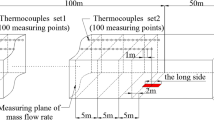Abstract
Air curtain is an effective means to stop the propagation of smoke in buildings to provide smoke-free area for safe egress of occupants in case of fires. To understand its effectiveness of smoke confinement in tunnel fires, full-scale tests were conducted in a tunnel of 140 m long and with varying heights of 5.0 m to 5.9 m and varying widths of 5.8 m to 10.8 m. A 20 cm-wide air curtain spanning entire lateral section was installed underneath the tunnel ceiling. The experiment showed that air curtain at exit velocities of 12 m/s and 16 m/s can stop the propagation of smoke produced by 1 MW fire and 2 MW fire respectively. Numerical simulation using ANSYS FLUENT was then conducted and the numerical results were basically consistent with those of experiment. To explore how the design parameters of air curtain, i.e., the width, the exit velocity and its angle, affect its effectiveness of smoke confinement at varying heat release rates, a number of numerical simulations were further conducted. The relationship of design parameters of air curtain with heat release rates was proposed and it can be used in the design of air curtain in tunnel fires.

































Similar content being viewed by others
References
Mashimo H (2002) State of the road tunnel safety technology in Japan. Tunn Undergr Space Technol Inc Trenchless Technol Res 17(2):145–152
Meng N, Hu LH, Zhu S, Yang LZ (2014) Effect of smoke screen height on smoke flow temperature profile beneath platform ceiling of subway station: an experimental investigation and scaling correlation. Tunn Undergr Space Technol 43(7):204–212
Alarie Y (2002) Toxicity of fire smoke. Crit Rev Toxicol 32(4):259–289
Fan CG, Ji J, Gao ZH, Han JY, Sun JH (2013) Experimental study of air entrainment mode with natural ventilation; using shafts in road tunnel fires. Int J Heat Mass Transf 56(1–2):750–757
Hietaniemi J, Kallonen R, Mikkola E (2015) Burning characteristics of selected substances: production of heat, smoke and chemical species. Fire Mater 23(4):171–185
Zhou Y, Yang Y, Mao ZL, Bu RW, Gong JH, Wang YX et al (2019) Analytical and numerical study on natural ventilation in single-and gable-slope city tunnels. Sustain Cities Soc 45:258–270
Atkinson GT, Wu Y (1996) Smoke control in sloping tunnels. Fire Saf J 27(4):335–341
Tang Z, Liu YJ, Yuan JP, Fang Z (2017) Study of the critical velocity in tunnels with longitudinal ventilation and spray systems. Fire Saf J 90:139–147
Li MX, Zhang ZJ, Milke J, Lu GJ, Mei XJ (2018) Experimental research on the smoke control system in a complex road tunnel fire. Procedia Eng 211:379–387
Shih YC, Yang AS, Lu CW (2011) Using air curtain to control pollutant spreading for emergency management in a cleanroom. Build Environ 46(5):1104–1114
Foster AM, Barrett R, James SJ, Swain MJ (2002) Measurement and prediction of air movement through doorways in refrigerated rooms. Int J Refrig 25(8):1102–1109
Chen YG, Yuan XL (2005) Experimental study of the performance of single-band air curtains for a multi-deck refrigerated display cabinet. J Food Eng 69(3):261–267
Hetsroni G, Hall CW, Dhanak AM (1963) Heat-transfer properties of an air curtain. Trans ASAE 6(4):328-0331
Gonçalves JC, Costa JJ, Figueiredo AR, Lopes AMG (2012) CFD modelling of aerodynamic sealing by vertical and horizontal air curtains. Energy Build 52(3):153–160
Vega MG (2008) Numerical 3D simulation of a longitudinal ventilation system: memorial tunnel case. Tunn Undergr Space Technol Inc Trenchless Technol Res 23(5):539–551
Ciocănea A, Dragomirescu A (2013) Modular ventilation with twin air curtains for reducing dispersed pollution. Tunn Undergr Space Technol Inc Trenchless Technol Res 37(6):180–198
Moureh J, Yataghene M (2016) Numerical and experimental study of airflow patterns and global exchanges through an air curtain subjected to external lateral flow. Exp Therm Fluid Sci 74:308–323
Zhang L, Yan ZZ, Li ZH, Wang XM, Han XF, Jiang JC (2018) Study on the Effect of the jet speed of air curtain on smoke control in tunnel. Procedia Eng 211:1026–1033
Krajewski G, Węgrzyński W (2015) Air curtain as a barrier for smoke in case of fire: Numerical modelling. Bull Pol Acad Sci Tech Sci 63(1):145–153
Ballesteros-Tajadura R, Santolaria-Morros C, Blanco-Marigorta E (2006) Influence of the slope in the ventilation semi-transversal system of an urban tunnel. Tunn Undergr Space Technol 21(1):21–28
Kang K (2006) Computational study of longitudinal ventilation control during an enclosure fire within a tunnel. J Fire Prot Eng 16(3):159–181
Lin P, Lo SM, Li T (2014) Numerical study on the impact of gradient on semi-transverse smoke control system in tunnel. Tunn Undergr Space Technol Inc Trenchless Technol Res 44(3):68–79
Li YZ, Ingason H (2018) Overview of research on fire safety in underground road and railway tunnels. Tunn Undergr Space Technol 81:568–589
Acknowledgements
The authors greatly acknowleged the financial support from National Natural Science Foundation of China (No. 1974161).
Author information
Authors and Affiliations
Corresponding author
Additional information
Publisher's Note
Springer Nature remains neutral with regard to jurisdictional claims in published maps and institutional affiliations.
Rights and permissions
About this article
Cite this article
Gao, D., Li, T., Mei, X. et al. Effectiveness of Smoke Confinement of Air Curtain in Tunnel Fire. Fire Technol 56, 2283–2314 (2020). https://doi.org/10.1007/s10694-020-00977-z
Received:
Accepted:
Published:
Issue Date:
DOI: https://doi.org/10.1007/s10694-020-00977-z




